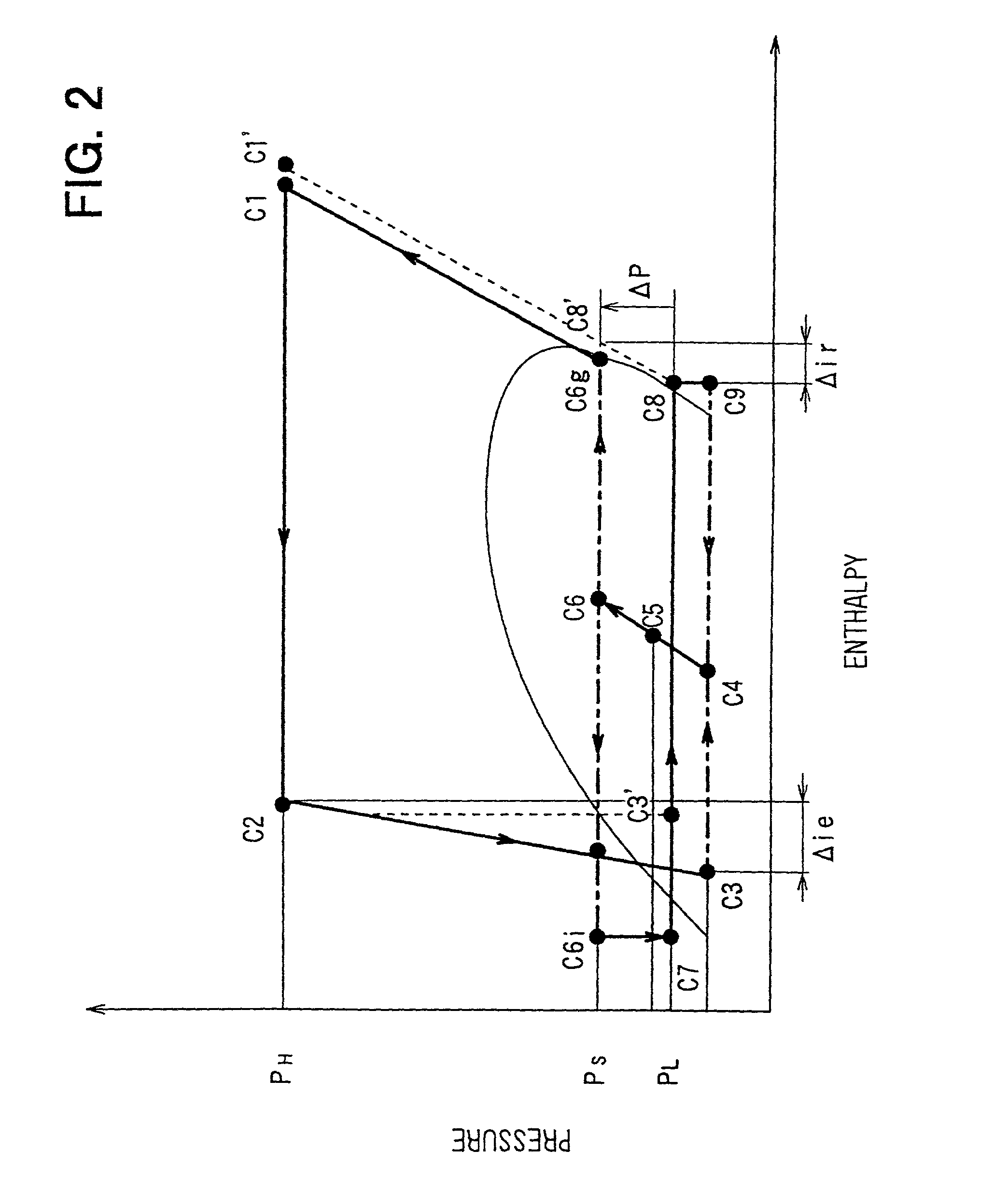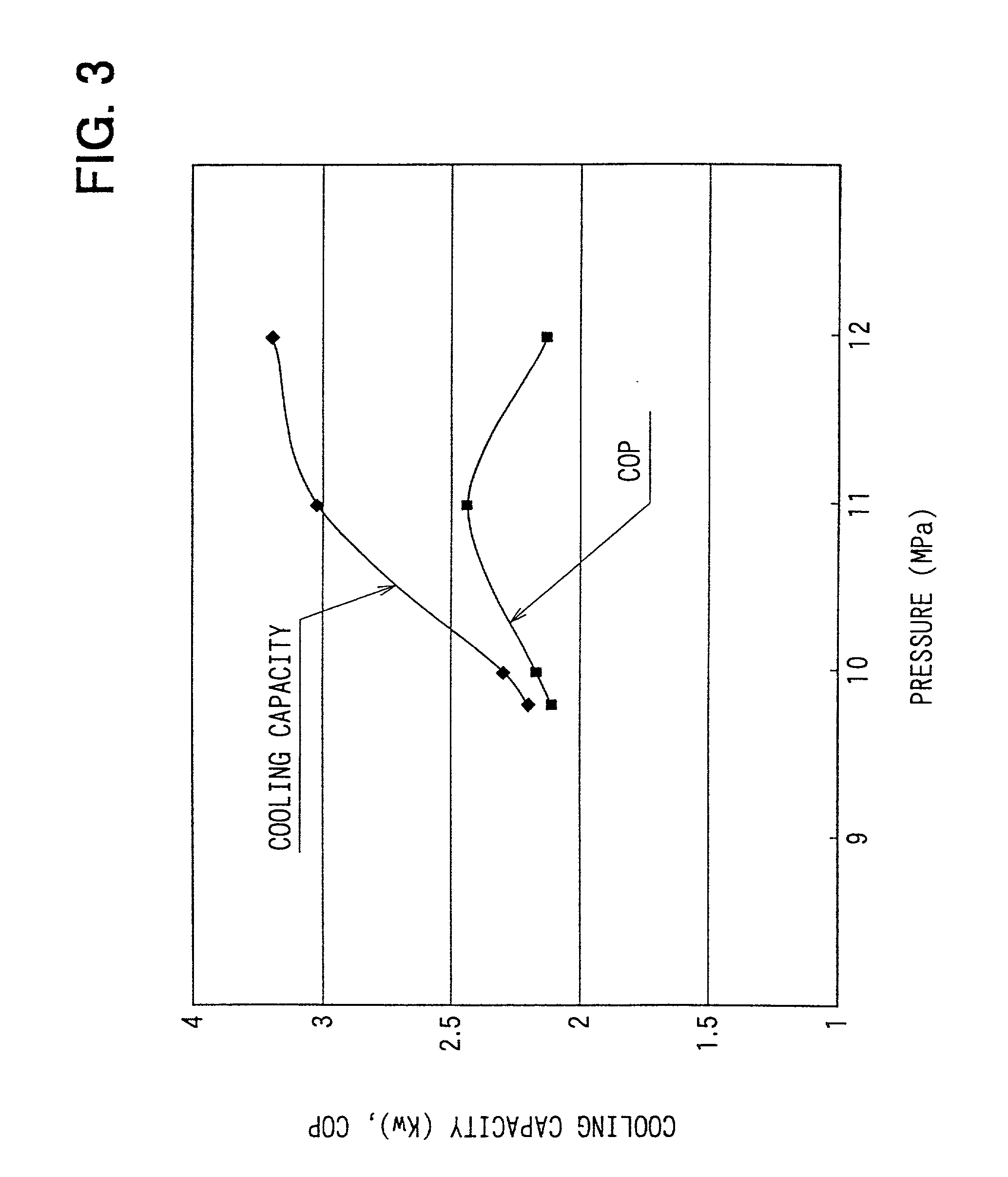Ejector cycle system with critical refrigerant pressure
a technology of ejector cycle and refrigerant pressure, which is applied in the operation mode of machines, refrigeration components, lighting and heating apparatus, etc., can solve the problems of reducing the coefficient of refrigerant cycle performance and increasing the power needed for operating a compressor
- Summary
- Abstract
- Description
- Claims
- Application Information
AI Technical Summary
Benefits of technology
Problems solved by technology
Method used
Image
Examples
first embodiment
[0062] A first preferred embodiment of the present invention will be now described with reference to FIGS. 1-3. In the first embodiment, an ejector cycle system of the present invention is typically applied to a reference cycle using carbon dioxide as refrigerant, for a vehicle air conditioner.
[0063] As shown in FIG. 1, a compressor 100 which sucks and compresses refrigerant using a driving force from a driving source such as a vehicle engine is disposed in the ejector cycle system. A radiator 200 (gas cooler) is disposed so that refrigerant discharged from the compressor 100 is heat-exchanged with outside air outside a passenger compartment and is cooled by outside air.
[0064] An evaporator 300 is disposed in the ejector cycle system so that air blown into the passenger compartment and liquid refrigerant flowing through the evaporator 300 are heat-exchanged. In the evaporator 300, cooling capacity can be obtained by the evaporation of liquid refrigerant. Refrigerant from the radiato...
second embodiment
[0074] A second preferred embodiment of the present invention will be now described with reference to FIG. 4. In the second embodiment, as shown in FIG. 4, a second decompression unit 710, which reduces the refrigerant pressure increased in the diffuser 430 of the ejector 400, is disposed at a downstream side of the ejector 400. Therefore, the increased pressure of refrigerant in the diffuser 430 of the ejector 400 is decompressed in the second decompression unit 710 to have a predetermined decompressed pressure lower than the critical pressure. Thereafter, refrigerant having the predetermined decompressed pressure lower than the critical pressure flows into the gas-liquid separator 500 to be sufficiently separated into gas refrigerant and liquid refrigerant.
[0075] In the ejector cycle system using carbon dioxide as refrigerant, because the high-pressure side refrigerant pressure is equal to or higher than the super-critical pressure (trans-critical pressure), the refrigerant pressu...
fourth embodiment
[0083] liquid refrigerant to be supplied to the evaporator 300 is separated and extracted from refrigerant before being discharged from the ejector 400. Therefore, as shown by the solid line in FIG. 8, even when the suction pressure increased amount .DELTA.P becomes larger, a pressure increased amount .DELTA.Pe of liquid refrigerant flowing from the gas-liquid separator 500 can be made smaller than the suction pressure increased amount .DELTA.P.
[0084] Accordingly, it can prevent the specific enthalpy of refrigerant at the inlet of the evaporator 300 from being larger, and the specific enthalpy difference .DELTA.he between the refrigerant inlet and the refrigerant outlet of the evaporator 300 can be made larger than the specific enthalpy difference .DELTA.h. As a result, the cooling capacity Qe generated by the evaporator 300 can be increased.
[0085] FIG. 9 shows a simulation result showing a relationship between a refrigerant flow speed (relative speed Vgi / Vgno) from the refrigerant...
PUM
 Login to View More
Login to View More Abstract
Description
Claims
Application Information
 Login to View More
Login to View More - R&D
- Intellectual Property
- Life Sciences
- Materials
- Tech Scout
- Unparalleled Data Quality
- Higher Quality Content
- 60% Fewer Hallucinations
Browse by: Latest US Patents, China's latest patents, Technical Efficacy Thesaurus, Application Domain, Technology Topic, Popular Technical Reports.
© 2025 PatSnap. All rights reserved.Legal|Privacy policy|Modern Slavery Act Transparency Statement|Sitemap|About US| Contact US: help@patsnap.com



